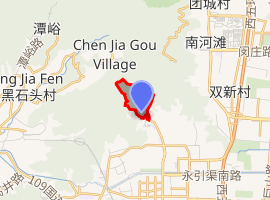Badachu
The Badachu (simplified Chinese: 八大处; traditional Chinese: 八大處; pinyin: bādàchǔ; also known as "Badachu Park"), is a complex of monasteries located on the outskirts of urban Beijing, which means "Eight Great Sites" that refers to the eight Buddhist temples and nunneries scattered across the Cuiwei, Pingpo, and Lushi hills in Shijingshan District, at the foot of Beijing's Western Hills.[1]
| Badachu Park | |
|---|---|
A pavilion in Badachu | |

| |
| Type | Urban park |
| Location | Beijing, China |
| Area | 332 hectares |
| Created | 7th century |
| Status | Open all year |
Temples & monasteries
- Chang'an Temple (长安寺), means the temple of Eternal Peace.
- Lingguang Temple (灵光寺), means the temple of Divine Light.
- Sanshan Nunnery (三山庵), means the nunnery of Three-hills.
- Dabei Temple (大悲寺), means the temple of Great Mercy.
- Longquan Nunnery (龙泉庵), means the nunnery of Dragon Spring.
- Xiangjie Temple (香界寺), means the temple of the Fragrant World.
- Baozhu Cave (宝珠洞), means the cave of Precious Pearl.
- Zhengguo Temple (正果寺), means the temple of Thoroughly Transform.
Visiting
Visitors can walk from one temple to another, viewing the area's scenery, arbor and rare ancient trees. Some of these trees have been standing for over six centuries, but their roots and branches are still strong and in good shape. In September and October, when the leaves are turning red, crowds of tourists come to climb the mountains. There is a cable-car to the top of the hill.
Gallery
- Treasure trunk pagoda at Lingguang Temple (Lingguangsi)
- Entrance to the Dabei Temple (Dabeisi)
- Entrance to the Xiangjie Temple (Xiangjiesi)
- Paifang at the Baozhu Cave
- Lingguang Temple, one of the eight monasteries located at Badachu
Notes
- Petra Häring-Kuan, Yu-Chien Kuan (1987). Magnificent China: a guide to its cultural treasures. Joint Publishing. p. 149. ISBN 962-04-0566-8.
External links
| Wikimedia Commons has media related to 八大处. |